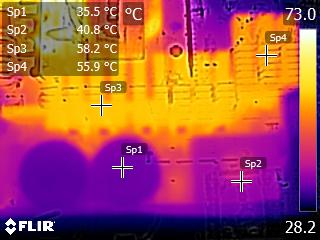Corsair RM850 Power Supply Review: A Solid Value
Why you can trust Tom's Hardware
Protection Features, DC Power Sequencing, Cross-Load Tests and Infrared Images
Protection Features
Check out our PSUs 101 article to learn more about PSU protection features.
| Protection Features | |
| OCP | 12V: 88.4A (124.86%), 11.973V 5V: 29A (145%), 5V 3.3V: 30A (150%), 3.301V 5VSB: 5.4A (180%), 4.898V |
| OPP | 1076.5W (126.65%) |
| OTP | ✓ (140°C @ 12V heat sink) |
| SCP | 12V: ✓ 5V: ✓ 3.3V: ✓ 5VSB: ✓ -12V: ✓ |
| PWR_OK | Proper Operation |
| NLO | ✓ |
| SIP | Surge: MOV Inrush: NTC Thermistor & Bypass Relay |
The triggering points of the Over Current Protection (OCP) on the minor rails are quite high, but they don't affect the load regulation. The 5VSB rail can also deliver much more power than its nominal, which may come in handy though, because the modern standby modes will put a heavy burden on this rail.
The Over Power Protection (OPP) is properly set, and there is Over Temperature Protection, which shuts down the PSU before the secondary heat sink gets overheated.
DC Power Sequencing
According to Intel’s most recent Power Supply Design Guide (revision 1.4), the +12V and 5V outputs must be equal to or greater than the 3.3V rail at all times. Unfortunately, Intel doesn't mention why it is so important to always keep the 3.3V rail's voltage lower than the levels of the other two outputs.



No problems here, since the 3.3V rail is always lower than the other two.
Cross Load Tests
To generate the following charts, we set our loaders to auto mode through custom-made software before trying more than 25,000 possible load combinations with the +12V, 5V, and 3.3V rails. The deviations in each of the charts below are calculated by taking the nominal values of the rails (12V, 5V, and 3.3V) as point zero. The ambient temperature during testing was between 30 to 32 degrees Celsius (86 to 89.6 degrees Fahrenheit).
Load Regulation Charts



Efficiency Chart
The above graph, clearly shows the high efficiency levels under light loads. If Corsair had set the maximum combined power of the minor rails at a lower level, since 150W is too much for any modern system, the overall efficiency would be even higher since the more you stress the DC-DC converters that generate the 5V and 3.3V rails, the higher are the energy losses on them.
Get Tom's Hardware's best news and in-depth reviews, straight to your inbox.
Ripple Charts
The lower the power supply's ripple, the more stable the system will be and less stress will be also applied to its components.




Infrared Images
We apply a half-load for 10 minutes with the PSU's top cover and cooling fan removed before taking photos with a modified FLIR E4 camera able to deliver an IR resolution of 320x240 (76,800 pixels).





Inside the power supply, the temperatures are at normal levels. As expected, the hottest part is the board hosting the +12V FETs, which is close to the DC-DC converters board.
MORE: Best Power Supplies
MORE: How We Test Power Supplies
MORE: All Power Supply Content
Current page: Protection Features, DC Power Sequencing, Cross-Load Tests and Infrared Images
Prev Page Load Regulation, Hold-Up Time, Inrush Current, Efficiency and Noise Next Page Transient Response Tests, Ripple Measurements and EMC Pre-Compliance Testing
Aris Mpitziopoulos is a contributing editor at Tom's Hardware, covering PSUs.
